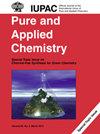全面评估新型 2-(丁氨基)乙醇基深共晶溶剂的物理性质和二氧化碳容量
IF 2
4区 化学
Q3 CHEMISTRY, MULTIDISCIPLINARY
引用次数: 0
摘要
本研究旨在评估烷醇胺深共晶溶剂(DES)的成分对这些溶剂的物理性质及其二氧化碳容量的影响。为了实现这一目标,我们以 2-(丁氨基)乙醇 (BAE) 作为氢键供体 (HBD),并以四丁基溴化铵 (TBAB)、四丁基氯化铵 (TBAC) 或四乙基氯化铵 (TEAC) 作为氢键受体 (HBA),以不同的摩尔比(1:6、1:8 和 1:10)合成了新型深共晶溶剂。为证实各组分之间存在氢键相互作用,进行了傅立叶变换红外光谱测量。此外,还考察了这些深共晶溶剂在 293.15-333.15 K 温度范围内和 0.1 MPa 压力下的热特性(包括熔点和热稳定性)以及关键物理性质(如密度、粘度、折射率和声速)。研究分析了 HBA 与 HBD 的摩尔比、阴离子类型和烷基链长度对理化性质的影响。在这项工作中,测量了二氧化碳在由 2-(丁氨基)乙醇、3-氨基-1-丙醇(AP)和 2-(甲氨基)乙醇(MAE)衍生的 DES 中的溶解度。TEAC:MAE 1:10 DES 的二氧化碳容量最高,其特点是 HBA 和 HBD 分子中的烷基链长度最短、胺含量最高、粘度最低。此外,还探讨了加水对二氧化碳溶解度的影响。结果表明,水对二氧化碳溶解度的影响因 DES 的类型而异。总之,这项研究突出表明,DES 可作为捕获二氧化碳的有效介质,其性能可通过改变氢键受体或供体的类型、摩尔比以及加水来调整。本文章由计算机程序翻译,如有差异,请以英文原文为准。
Comprehensive evaluation of physical properties and carbon dioxide capacities of new 2-(butylamino)ethanol-based deep eutectic solvents
The aim of this research was to assess the impact of the components of alkanolamine deep eutectic solvents (DESs) on the physical properties of those DESs and their carbon dioxide capacity. To achieve this goal, novel deep eutectic solvents were synthesized by using 2-(butylamino)ethanol (BAE) as the hydrogen bond donor (HBD), along with tetrabutylammonium bromide TBAB), tetrabutylammonium chloride (TBAC), or tetraethylammonium chloride (TEAC) as the hydrogen bond acceptors (HBA) at various molar ratios (1:6, 1:8, and 1:10). To confirm the presence of hydrogen bond interactions between the components Fourier Transform Infrared Spectroscopy measurements were conducted. Furthermore, thermal properties, including melting points and thermal stability, of these deep eutectic solvents as well as key physical properties, such as density, viscosity, refractive index, and sound velocity, within the temperature range of 293.15–333.15 K and at a pressure of 0.1 MPa were examined. The effect of the molar ratio of HBA to HBD, the type of anion, and the length of the alkyl chain were studied and analysed in regard to physicochemical properties. In this work, the solubility of carbon dioxide in DESs derived from 2-(butylamino)ethanol, 3-aminopropan-1-ol (AP), and 2-(methylamino)ethanol (MAE) was measured. The highest CO2 capacity was found for TEAC:MAE 1:10 DES characterized by the shortest alkyl chain length in both HBA and HBD molecules, the highest amine content, and the lowest viscosity. Additionally, the effect of water addition on carbon dioxide solubility was explored. The results showed that the influence of water on CO2 solubility varies with the type of DES. In general, this work highlighted that DESs can serve as effective media for carbon dioxide capture, and their performance can be tailored by changing the type of hydrogen bond acceptor or donor, their molar ratio and by the addition of water.
求助全文
通过发布文献求助,成功后即可免费获取论文全文。
去求助
来源期刊

Pure and Applied Chemistry
化学-化学综合
CiteScore
4.00
自引率
0.00%
发文量
60
审稿时长
3-8 weeks
期刊介绍:
Pure and Applied Chemistry is the official monthly Journal of IUPAC, with responsibility for publishing works arising from those international scientific events and projects that are sponsored and undertaken by the Union. The policy is to publish highly topical and credible works at the forefront of all aspects of pure and applied chemistry, and the attendant goal is to promote widespread acceptance of the Journal as an authoritative and indispensable holding in academic and institutional libraries.
 求助内容:
求助内容: 应助结果提醒方式:
应助结果提醒方式:


